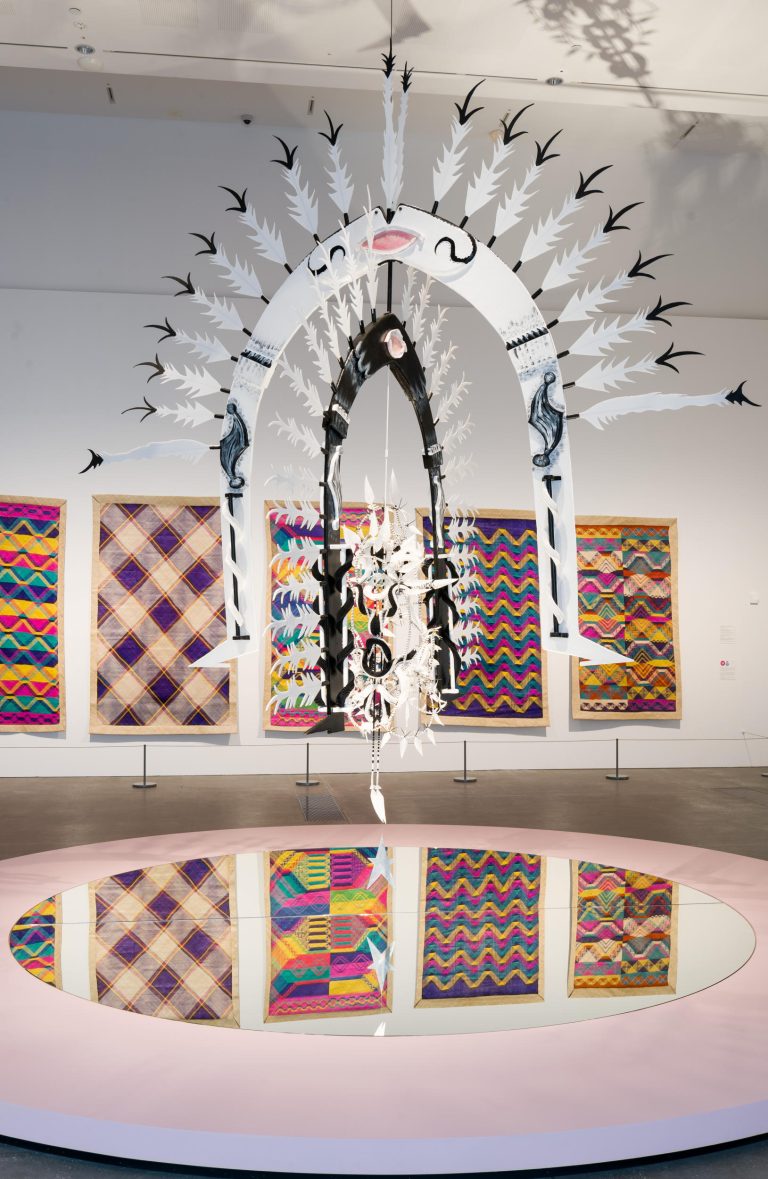We acknowledge the Traditional Owners of the land on which the Queensland Art Gallery | Gallery of Modern Art stands and recognise the creative contribution First Australians make to the art and culture of this country.

Grace Lillian Lee / Meriam Mir people / Australia b.1988 / Ken Thaiday Snr / Meriam Mir people / Australia b.1950 / Suggoo Pennise (APT10 installation view) 2021 / Kinetic sculpture; hand-carved plywood, synthetic polymer paint, cane, feathers, cotton webbing, mirrored glass and mechanical rotation device / 350 x 300cm (approx.) / © The artists / Photograph: QAGOMA
Grace Lillian Lee and Ken Thaiday SnrSuggoo Pennise 2021
Not Currently on Display
Suggoo Pennise is a collaborative work by Grace Lillian Lee and Ken Thaiday Snr. It takes the form of an oversized, kinetic Dhari (headdress), which combines and enhances both artists’ respective practices.
Adorned with designs that represent the fish traps on Erub (Darnley Island) and the beizam (tiger shark, a significant totem of the Meriam Clan) jaw motif, it contemporises the traditional form of the Dhari worn by Torres Strait warriors in battle. It is a potent symbol of the Torres Strait Island people, appearing on their flag today as a sign of peace and harmony. The Dhari’s brightly coloured woodcarving designs are revealed as it rotates around Lee’s central woven body sculpture, which features her signature ‘grasshopper’ double weave evolved from the technique Thaiday first taught her.
The sculpture also represents a blue-ringed octopus. Lee explains: ‘Uncle Ken talks about my weaves being a representation of the octopus and how you can find them within the fish trap’.1 The octopus has many layers of significance — its form embodies Malo-Bomai spirituality, which recognises the unification of the eight clans of Mer and the establishment of laws of the land and water by heroic beings, Malo and Bomai.
Endnotes:
1 Grace Lillian Lee in conversation with Ken Thaiday Snr, Gimuy (Cairns), May 2021.
Grace Lillian Lee is a multicultural Australian artist and designer descended from the Meriam Mir people of the eastern islands of the Torres Strait. Lee’s woven necklaces and body sculptures, made using pre-dyed cotton webbing, are a modern interpretation of a technique she learnt from her mentor, renowned artist Dr Ken Thaiday Snr. Thaiday first taught her to weave with palm fronds, using a technique referred to in the Torres Strait as a ‘grasshopper weave’ that now forms a crucial part of Lee’s practice.
Lee is the founder of First Nations Fashion and Design (FNFD), an initiative she established to support others in the fashion industry. Lee also collaborates with Australian Indigenous communities and their art centres to create a platform for young people to celebrate their culture through fashion and performance.
Thaiday was born in 1950 on Erub (Darnley Island) in the outer Torres Strait, one of Australia’s most remote communities. He spent his childhood with his family, fishing, gardening and participating in ceremonial life. When he was about 13, the family moved to Waiben (Thursday Island), where he attended school, and two years later they settled in Cairns.
In the 1980s, Thaiday became a leader in the creation of Torres Strait dance objects when he formed a dance troupe to perform at traditional tombstone ceremonies in north Queensland. While spectacular headdresses have become his best-known works, he also creates dance weapons, zamiyakal (articulated dance machines), paddles and musical instruments. His artworks are based on the rich history and narratives of the Torres Strait Islands.